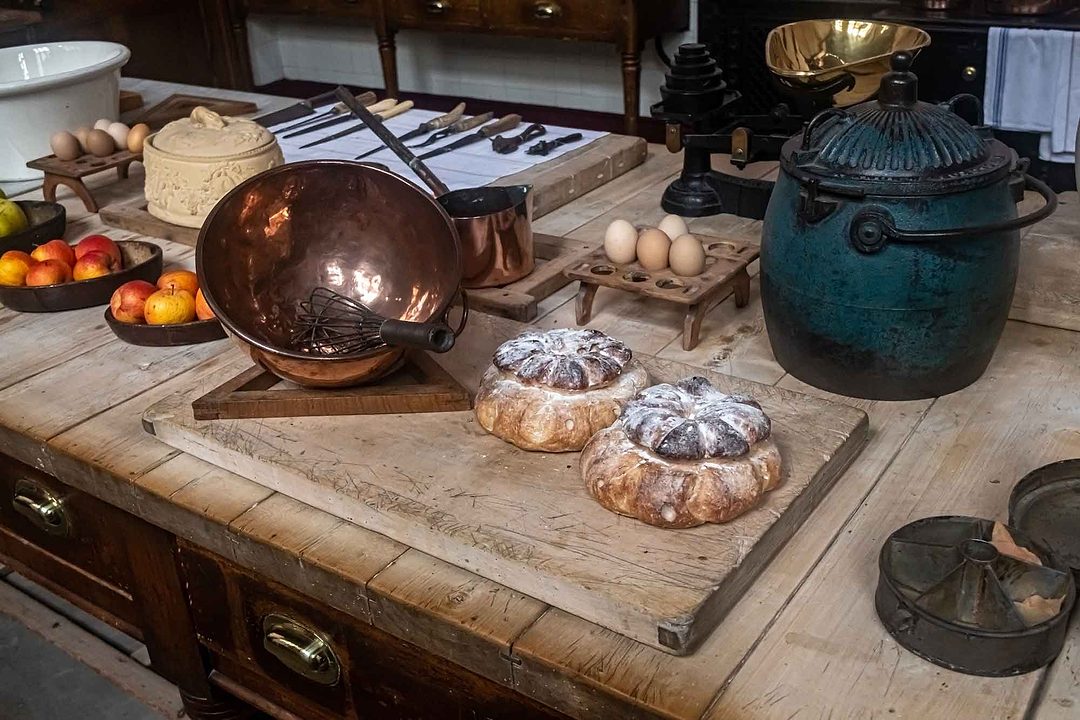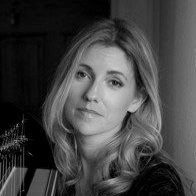
QUESTIONS
Questions 1 - 3: The year is 1882. You have recently been hired as a cook in a Concord household. You lied on your resume and have actually never cooked before, but you can read and have a few recipes your cousin’s friend tore out of an old receipt (recipe) book for you. (How hard can it be?) Giving a new definition to sweating in the kitchen, can you figure out the first three questions?
1. Your first recipe is a savory pie that calls for an “exaltation” to be mixed with breadcrumbs, herbs, vegetables, and stock and placed in a pastry crust. What is an “exaltation?”
A. Salted cow hooves
B. Multiple larks
C. Whipped cream
D.
A prayer uttered loudly (you should have known this was a bad idea!)
Click to show the answer
A. Salted cow hooves
B. Multiple larks
C. Whipped cream
D. A prayer uttered loudly (you should have known this was a bad idea!)
Answer: B. Multiple larks are called an “exaltation.” The 1882 cookbook 366 Menus and 1200 Recipes of the Baron Brisse recommends you use at least two to three dozen larks per pie, and if the seasoning is not enough, wrap them in bacon. Your guests will be singing your culinary praises.
2. Your new employer pops their head into the kitchen to confirm the “Bermuda Witches” will be at the dinner. Are they referring to:
A.
Lamb in a simmered rum sauce garnished with radish
B. Their visiting stepsisters
C.
Descendants of convicted Salem witches who now live in Concord
D.
A cake covered with jelly and freshly grated cocoa-nut
E.
You have no idea. Just smile, nod, and
say, “yes.”
Click to show the answer
A. Lamb in a simmered rum sauce garnished with radish
B. Their visiting stepsisters
C. Descendants of convicted Salem witches who now live in Concord
D. A cake covered with jelly and freshly grated cocoa-nut
E. You have no idea. Just smile, nod, and say, “yes.”
Answer: D. A cake covered with jelly and freshly grated cocoa-nut. Try your hand making Bermuda Witches with this (condensed) recipe from Eliza Acton’s 1882 cookbook, Modern Cookery For Private Families: New Edition, published in London by Longmans, Green, Reader, and Dyer. “[Thinly] slice equally some rice, pound, or Savoy cake; spread one half of it with Guava jelly, or with fine strawberry, raspberry, or currant jelly of the best quality… on this strew thickly some fresh cocoa-nut grated small and lightly; press [it]over the remainder of the cake, and trim [the slices]…pile them slopingly in the centre of a dish upon a very white napkin folded flat, and garnish them with small sprigs of myrtle.”
3. Your employer wants “green” ice cream for the holiday dinner. Ice cream has been in Massachusetts since the Colonial
era so you are familiar with it, but what should you do to make the ice cream green?
A.
Pre-make it and leave it on the counter for a week until it looks green enough, and then refreeze it
B. Add pickled-lime juice
C.
Add specially prepared boiled spinach
D.
Add Crème de Menthe
Click to show the answer
C. Add specially prepared boiled spinach
D. Add Crème de Menthe
Answer: C. Add specially prepared boiled spinach. If you answered D, Crème de Menthe, you were close, but it wasn’t invented until 1885 by pharmacist Emile Giffard, who was experimenting with the benefits of mint. So, for this question, enjoy your spinach-flavored ice cream. Dying to make your own? Find a recipe in famed Victorian-era chef Agnes B. Marshall’s cookbook The Book of Ices.
4. December 20, 1774. Concord’s Reverend William Emerson and his wife, Phebe Bliss, are visiting your Concord house. You have some lovely East India Company tea stored in your kitchen. Should you offer them a cup? Yes, no, or maybe?
Click to show the answer
Answer: Yes, No, and Maybe. Although Phebe Bliss came from a family of Loyalists, her husband, the Reverend William Emerson, was an ardent supporter of the Patriot cause. On October 20, 1774, in response to the Intolerable Acts and other perceived injustices against the colonists by distant Parliament, the First Continental Congress agreed to a boycott of British goods. The boycott went into effect on December 1, 1774, and included the language that “from and after the first day of March next we will not purchase or use any East India tea whatsoever.” That’s March of 1775… so if you have it, you could serve it to the Emersons, but you may wish to let the decision steep until you read the room.
5. In his essay “Wild Apples,” Henry David Thoreau wrote about an old English custom practiced on New Year’s Eve when groups of boys would gather in apple orchards, encircle the apple trees, and repeat a chant encouraging the trees to grow strong through the winter. What was the name of this custom?
A. Bough-Lifting
B.
Apple-Howling
C.
The Ritual of Rootimus Profundus
D.
Muggle-Incanting
Click to show the answer
A. Bough-Lifting
B. Apple-Howling
C. The Ritual of Rootimus Profundus
D. Muggle-Incanting
Answer: B. Apple-Howling. Standing in circles around the apple trees, the boys would chant,
“Stand fast, root! Bear well, top!
Pray God send us a good howling crop:
Every twig, apples big;
Every bough, apples enow!”
6. On Christmas Eve of 1854, twenty-two-year-old Louisa May Alcott placed what she called her “first born” into her mother’s Christmas stocking as a gift. What was this “first born?”
Click to show the answer
Answer: Louisa’s first book, Flower Fables. Written when Louisa was sixteen years old, Flower Fables was a collection of short stories Louisa wrote for Ralph Waldo Emerson’s youngest daughter, Ellen. Years later, the book was published just in time for Louisa to place the finished novel into her mother’s stocking on Christmas Eve. In the accompanying letter to her mother, Louisa wrote, “I hope to pass in time from fairies and fables to men and realities.”
7. Which Concord author who lived at The Wayside wrote a book that featured a family that was too poor to have a Christmas?
Click to show the answer
Answer: Harriot Lothrop. Lothrop, who wrote under the name Margaret Sidney, wrote most of the Five Little Pepper books while living at The Wayside, a house that was formerly occupied by the Alcotts and the Hawthornes. In The Five Little Peppers and How They Grew, little Davie observed that the children “never had a Christmas.” His sister, Polly, often begged her mother to hang up stockings for her younger siblings, “but there was never anything to put in them, and the winters were cold and hard, and the strictest economy only carried them through.”
8. Louisa May Alcott wrote Little Women, Part First in 1868. The volume’s opening line begins with Jo March bemoaning, “Christmas won’t be Christmas without any [what]?”
A.
Christmas tree
B.
Presents
C.
Snow
D.
Kittens
Click to show the answer
A. Christmas tree
B. Presents
C. Snow
D. Kittens
Answer: B. Presents. “’Christmas won’t be Christmas without any presents’” grumbled Jo, lying on the rug.”
9. In Little Women, on Christmas morning the March sisters give their Christmas breakfast away to a poor family in need. That evening, their wealthy neighbor,
Mr. Laurence, gifts the family a lavish Christmas dinner. The meal includes “white and pink ice cream.” What ingredient could have made the ice cream pink? Select all that apply.
A.
Nectarines
B.
Strawberries
C.
Cow’s Blood
D.
Cochineal Powder
Click to show the answer
A. Nectarines
B. Strawberries
C. Cow’s Blood
D. Cochineal Powder
Answer: B (Strawberries) and D (Cochineal Powder). As described in J. Thomson’s 1877 book Street Life in London, cochineal powder was used in ice creams to give a red color. Other than adding a grainy texture, cochineal did not contribute to the taste. Which is good since it was made of crushed bugs.
10. Some gifts are hard to top. In 1884,
as a sign of friendship, France presented what gift to America?
A.
The Statue of Liberty
B.
A crown once worn by King George III
and captured by France
C.
The hat and sword of British General Cornwallis surrendered at the Battle of Yorktown
D.
A mural-sized painting of John Adams, George Washington, and Gilbert du Motier, Marquis de Lafayette
Click to show the answer
B. A crown once worn by King George III and captured by France
C. The hat and sword of British General Cornwallis surrendered at the Battle of Yorktown
D. A mural-sized painting of John Adams, George Washington, and Gilbert du Motier, Marquis de Lafayette
Answer: A: The Statue of Liberty. Designed by French sculptor Auguste Bartholdi, the statue’s construction was started in 1876 and finished in 1884 when it was formally gifted to the United States. Giving definition to “some assembly required,” the statue was disassembled in France into 350 pieces, packed into 214 crates, and shipped to America where it was reassembled on Bedloe’s Island. Today, the island is called Liberty Island, and the statue is maintained by the United States Park Service.
Contact Barrow Bookstore for a list of sources. Barrowbookstore@gmail.com.
————————————————————————
For more than 50 years, Barrow Bookstore has been a favorite of residents and visitors alike, specializing in Concord authors and history, children’s books and literature. The shop also provides a wide array of gently read and rare titles ranging from paperbacks to first editions and original manuscripts. Staff members have all worked as tour guides and reenactors in Concord and are happy to share their knowledge about the town and its history. Discover more at barrowbookstore.com.


